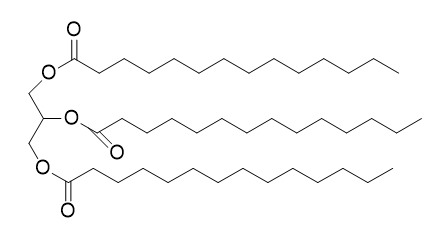Glycerol trimyristate
Glycerol trimyristate has a positive effect on the sperm viability.
Inquire / Order:
manager@chemfaces.com
Technical Inquiries:
service@chemfaces.com
Tel:
+86-27-84237783
Fax:
+86-27-84254680
Address:
1 Building, No. 83, CheCheng Rd., Wuhan Economic and Technological Development Zone, Wuhan, Hubei 430056, PRC
Providing storage is as stated on the product vial and the vial is kept tightly sealed, the product can be stored for up to
24 months(2-8C).
Wherever possible, you should prepare and use solutions on the same day. However, if you need to make up stock solutions in advance, we recommend that you store the solution as aliquots in tightly sealed vials at -20C. Generally, these will be useable for up to two weeks. Before use, and prior to opening the vial we recommend that you allow your product to equilibrate to room temperature for at least 1 hour.
Need more advice on solubility, usage and handling? Please email to: service@chemfaces.com
The packaging of the product may have turned upside down during transportation, resulting in the natural compounds adhering to the neck or cap of the vial. take the vial out of its packaging and gently shake to let the compounds fall to the bottom of the vial. for liquid products, centrifuge at 200-500 RPM to gather the liquid at the bottom of the vial. try to avoid loss or contamination during handling.
Pharmacol Res.2020, 161:105205.
Viruses.2017, 9(10)
LWT2021, 138:110397.
Nutrients.2024, 16(19):3266.
JAOCS2021, 98(7):779-794.
J Appl Biol Chem.2024, 67:39,281-288.
J Int Med Res.2021, 49(7):3000605211032849.
J Pharm Biomed Anal.2023, 234:115570.
Appl. Sci.2024, 14(12), 5280.
J Appl Biol Chem2021, 64(3):245-251.
Related and Featured Products
Journal of Japan Oil Chemists Society, 1986,35(4):293-299.
Studies on Applications of Lipolytic Enzymes in Detergency. IV.[Reference:
WebLink]
METHODS AND RESULTS:
To evaluate the effects of lipase on the removal of saturated triacylglycerol, the removal of both unitary and mixed soils of four types of saturated triacylglycerols (glycerol trilaurate, Glycerol trimyristate, glycerol tripalmitate, glycerol tristearate) and unsaturated glycerol trioleate from cotton fabrics was examined using various lipases and by changing the surfactant and pH of washing solutions. Microbial lipases of Candida cylindracea (Can-1 and Can-2), Mucor sp. (Mu-1 and Mu-2), Rhizopus arrhizus (Rhi) and Pseudomonas (Pse), and pocine pancreatic lipase (Pan) were used.
In the removal of a unitary soil of saturated triacylglycerol using only a surfactant solution, removal was found to become progressively easier as the chain length became shorter. The extent of individual removal of a saturated triacylglycerol from a mixed soil was low, while removal of glycerol trioleate in a mixed soil occurred more easily.
In the removal of a unitary soil by a surfactant solution containing lipase, the lipase had effect only on the removal of glycerol trilaurate among saturated triacylglycerols. In the removal of a mixed soil at both pH 7.0 and 10.0, lipase preferentialy facilitated the removal of glycerol trioleate and only to a very slight extent that of saturated triacylglycerols. In the removal of glycerol trilaurate using various lipases, lipase was more effective in the monoalkyl deca (oxyethylene) ether (APE) system than in sodium lauryl sulfate (SDS) system.
CONCLUSIONS:
In the APE system, all lipases except Pse were noted to have effect and in SDS system, Can-1, Mu-1, Mu-2 and Pan were effective. The effects of lipase at pH 10.0 were less pronounced than that at pH 7.0.For the more efficient removal of saturated triacylglycerol, the removal of glycerol tripalmitate was examined under various washing conditions. Increased lipase concentration was found to enhance removal.
Pharmaceutical Biology, 1999,29:155-157.
Note Chemical Investigation of the Stem Bark and Seeds of Staudtia kamerunensis.[Reference:
WebLink]
METHODS AND RESULTS:
The stem bark and seeds of Staudtia kamerunensis have been investigated for the first time. From the hexane extract of the seeds, glycerol tritetradecanoate (trimyristin, Glycerol trimyristate) and six lignans were isolated.
CONCLUSIONS:
These lignans are: otobain, hydroxyotobain, otobaphenol, licarin A, licarin B and (–) dihydroxyguaiaretic acid. The ethyl acetate extract of the stem bark gave a seventh lignan, otobuene.



